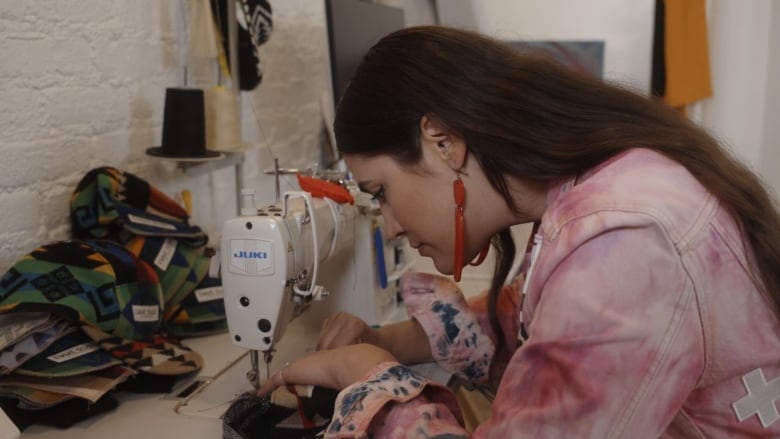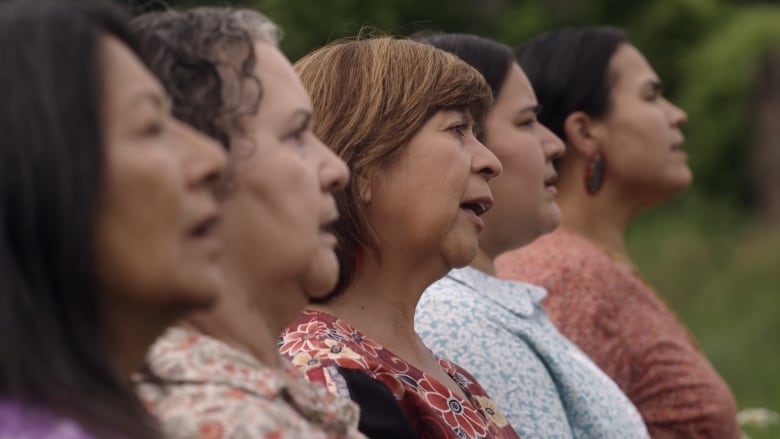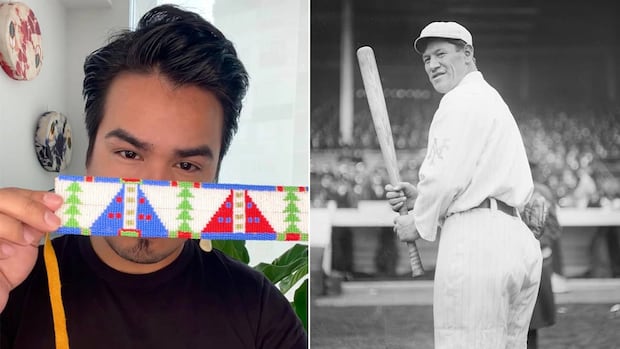
What started as a film about cultural appropriation evolved into something much deeper for Canadian filmmakers Neil Diamond and Catherine Bainbridge.
Red Fever, which opened in theatres Friday, sets out to find the roots of the Western world’s fascination with the stereotypical imagery of Indigenous people that still permeates pop culture, and why Indigenous culture continues to be revered, romanticized and ripped off.
Or, as Diamond asks in the film, tongue in cheek, “Why do they love us so much?”
“It evolved into a film about the influence of Native American cultures on Western society and through fashion, sports, politics, and the environment,” said Diamond, who is Cree and from Waskaganish, in northern Quebec.
“I’m kind of glad too, because it makes for a much deeper and richer, more interesting film.”
Diamond is both behind and in front of the camera in Red Fever as the documentary travels through North America and Europe, from the Arctic to the Deep South, exploring Indigenous histories and their lasting impact on today’s culture.
Sports, fashion and film
Diamond and Bainbridge previously worked together on the 2009 documentary Reel Injun, which examined the portrayal of Indigenous people through cinematic history. At the time, they thought the stereotyping was coming to an end, as they witnessed a renaissance in Indigenous filmmaking.
Then came the Twilight series, Avatar, Lone Ranger and a string of other films that fell back on stereotypical portrayals of Indigenous people, which pushed them to explore the idea of cultural appropriation.
But when the COVID-19 pandemic hit, Diamond and Bainbridge were forced to halt their work while they watched conversations about culture and privilege shift in the wake of the police killing of George Floyd and the Black Lives Matter movement.
Eyou Dipajimoon (Cree)20:45Neil Diamond is a Cree filmmaker from Waskaganish. He just released a new film called Red Fever.
Red Fever is a film that uncovers how Indigenous cultures were revered or copied by the western and non native culture.
Conversations about cultural appropriation were suddenly going mainstream, inspiring them to change their approach.
“It seemed like that conversation was done, in the sense that people knew you weren’t supposed to appropriate anymore, that it wasn’t a good thing to do. But we had a strong suspicion that people didn’t exactly know why, and they might have been afraid or too shy to ask,” Bainbridge said.
“We started saying, ‘Well, let’s get at the root of things here. And why this deep love, why appropriation, where does it come from? What’s underneath it all?”
Red Fever co-director Catherine Bainbridge explains how the documentary evolved from an exploration of cultural appropriation to something much deeper.
The film starts by looking at Indigenous influence in high fashion, weaving in historical anecdotes like a famous parka worn by an Inuit shaman in the early 1900s that was ripped off by U.K. design label KTZ, who later apologized.
It then moves into the use of Indigenous names and faces as sports mascots and logos, taking viewers back to the dominance of Carlisle Indian Industrial School team in early American college football.
Carlisle was an American Indian boarding school — the equivalent of Canada’s residential schools — where Indigenous children went after being forcibly taken from their families, with the aim of assimilating them into European culture, and were often mistreated and abused.
One of the team’s star players, James Thorpe, a member of the Sac and Fox Nation, went on to be the NFL’s first president and was called the greatest athlete of the 20th Century.
Beyond his athletic prowess, Jim Thorpe’s legacy is also about Indigenous representation. A proud member of the Sac and Fox Nation, he embraced his heritage and became a symbol of hope for Indigenous people, proving that they too could achieve greatness in a world that often marginalized them.
The roots of democracy
But Red Fever goes beyond pop culture to the very roots of American democracy, highlighting the oft-forgotten Indigenous influence on the politics that shaped America.
The film explores the founding fathers’ reverence for the Haudenosaunee Confederacy, often described as the world’s oldest participatory democracy and the model for the U.S. Constitution.
Diamond says the very notion of freedom in America, as ironic as it may seem, comes from the Haudenosaunee people.

“Imagine a people coming from Europe who had lived under kings and queens for generations and generations and they knew nothing about individual freedom. And they come here and they see a people who don’t bow down to kings,” Diamond said.
“I think that’s really why the [American] revolution happened, and the idea of individual freedom. Because of that. They saw people who were completely free.”
Red Fever explores how the founding fathers borrowed from Haudenosaunee values and diplomacy in their efforts to unite the 13 colonies, inspired by the way the Haudenosaunee had brought six nations together to work for a greater good.
While in awe of Indigenous people’s intelligence and ways of communication, the settler men mocked the Haudenosaunee men’s deference to women, as clan mothers had the final say on major decisions. But this was eye-opening for early suffragists, who wrote extensively of their admiration for Haudenosaunee society.
It has been documented that some European women taken captive by Indigenous tribes did not want to reintegrate into European society, after finding they were respected more by their captors. Bainbridge says it is important to remember that, at the time, women coming from Europe faced “tremendous violence” and had virtually no rights.
“You were absolutely null in the law. You were the property of your father, and then you were the property of your husband,” she said.

Sharing history to improve the future
Of course, the settlers ultimately betrayed the land’s original inhabitants, carrying out massacres and forcibly taking the land where Indigenous people had made their homes for generations.
Bainbridge says people mostly hear about the violence from that time period, and often forget about the critical communication that happened between early settlers and Indigenous people.
Bainbridge said Indigenous knowledge and culture is starting to gain more mainstream respect in recent years, notably in the scientific world, and she hopes that reminding people of those early connections can help build better futures for all of us.
“I really hope that young people look to this film, because I notice a lot of young people are looking for an alternative to get out of this trap we’re in, this trap the whole world is in,” she said.
“They’re looking for alternatives — alternative ways of thinking, alternative value systems. And Indigenous cultures have alternatives that have existed for thousands and thousands of years here; profoundly sophisticated concepts and ideas that are finally being looked at with respect.”

